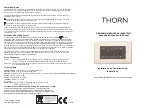
xStack
®
DGS-3400 Series Layer 2 Gigabit Ethernet Managed Sw itch
15
Parameter Description
BOOTP
The Switch will send out a BOOTP broadcast request when it is powered up. The BOOTP protocol
allows IP addresses, network masks, and default gateways to be assigned by a central BOOTP
server. If this option is set, the Switch will first look for a BOOTP server to provide it with this
information before using the default or previously entered settings.
DHCP
The Switch will send out a DHCP broadcast request when it is powered up. The DHCP protocol
allows IP addresses, network masks, and default gateways to be assigned by a DHCP server. If
this option is set, the Switch will first look for a DHCP server to provide it with this information
before using the default or previously entered settings.
Manual
Allows the entry of an IP address, Subnet Mask, and a Default Gateway for the Switch. These
fields should be of the form xxx.xxx.xxx.xxx, where each xxx is a number (represented in decimal
form) between 0 and 255.
IP Address
This address should be a unique address on the network assigned for use by the network
administrator. The form should be xxx.xxx.xxx.xxx, where each xxx is a number (represented in
decimal form) between 0 and 255.
Subnet Mask
A Bitmask that determines the extent of the subnet that the Switch is on. Should be of the form
xxx.xxx.xxx.xxx, where each xxx is a number (represented in decimal) between 0 and 255. The
value should be 255.0.0.0 for a Class A network, 255.255.0.0 for a Class B network, and
255.255.255.0 for a Class C network, but custom subnet masks are allowed.
Default
Gateway
IP address that determines where packets with a destination address outside the current subnet
should be sent. This is usually the address of a router or a host acting as an IP gateway. If your
network is not part of an intranet, or you do not want the Switch to be accessible outside your local
network, you can leave this field unchanged.
VLAN Name
This allows the entry of a VLAN Name from which a management station will be allowed to manage
the Switch using TCP/IP (in-band via Web manager or Telnet). Management stations that are on
VLANs other than the one entered here will not be able to manage the Switch in-band unless their
IP addresses are entered in the
Security IP Management
window. If VLANs have not yet been
configured for the Switch, the default VLAN contains all of the Switch's ports. There are no entries
in the Security IP Management table, by default, so any management station that can connect to
the Switch can access the Switch until a management VLAN is specified or Management Station IP
Addresses are assigned.
Click
Apply
to implement the changes.
This window also contains the current IPv6 setup on the Switch. Configuring IPv6 interfaces can be done in under the Interface
Settings
heading, by clicking the link
IPv6 Interface Settings
, which will be discussed in the next section.
Setting the Switch's IP Address using the Console Interface
Each Switch must be assigned its own IP Address, which is used for communication with an SNMP network manager or other
TCP/IP application (for example BOOTP, TFTP). The Switch's default IP address is 10.90.90.90. The default Switch IP address
can be changed to meet the specification of your networking address scheme.
The IP address for the Switch must be set before the Web-based manager can manage the switch. The Switch IP address can be
automatically set using BOOTP or DHCP protocols, in which case the actual address assigned to the Switch must be known. The
IP address may be set using the Command Line Interface (CLI) over the console serial port as follows:
•
Starting at the command line prompt, enter the commands
config ipif System ipaddress xxx.xxx.xxx.xxx/
yyy.yyy.yyy.yyy.
Where the x's represent the IP address to be assigned to the IP interface named System and the y's
represent the corresponding subnet mask.
•
Alternatively, the user can enter
config ipif System ipaddress xxx.xxx.xxx.xxx/z.
Where the x's represent the IP
address to be assigned to the IP interface named
System
and the z represents the corresponding number of subnets in
CIDR notation.
The IP interface named System on the Switch can be assigned an IP address and subnet mask, which can then be used to connect a
management station to the Switch's Telnet or Web-based management agent.
Содержание xStack DGS-3427
Страница 134: ...xStack DGS 3400 Series Layer 2 Gigabit Ethernet Managed Switch 125 Figure 2 148 Port Speed Utilizing the Tool Tip ...
Страница 215: ...xStack DGS 3400 Series Layer 2 Gigabit Ethernet Managed Switch 206 Figure 3 68 LLDP Local Port Brief Table window ...
Страница 354: ...xStack DGS 3400 Series Layer 2 Gigabit Ethernet Managed Switch 345 Figure 6 81 JWAC Global State Configuration window ...
Страница 404: ...xStack DGS 3400 Series Layer 2 Gigabit Ethernet Managed Switch 395 Example topology ...
Страница 406: ...xStack DGS 3400 Series Layer 2 Gigabit Ethernet Managed Switch 397 ...
















































